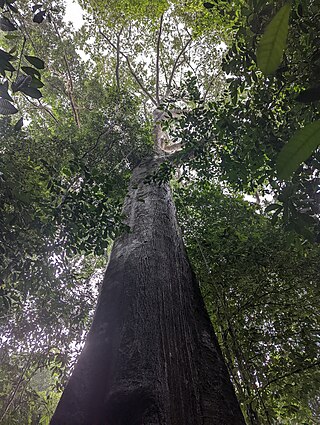
Meliaceae, the mahogany family, is a flowering plant family of mostly trees and shrubs in the order Sapindales.
The Catalogue of Life is an online database that provides an index of known species of animals, plants, fungi, and microorganisms. It was created in 2001 as a partnership between the global Species 2000 and the American Integrated Taxonomic Information System. The Catalogue is used by research scientists, citizen scientists, educators, and policy makers. The Catalogue is also used by the Biodiversity Heritage Library, the Barcode of Life Data System, Encyclopedia of Life, and the Global Biodiversity Information Facility. The Catalogue currently compiles data from 165 peer-reviewed taxonomic databases that are maintained by specialist institutions around the world. As of September 2022, the COL Checklist lists 2,067,951 of the world's 2.2m extant species known to taxonomists on the planet at present time.

Sandoricum is an Asian genus of plants in the family Meliaceae. It contains the economically significant santol fruit tree.

Woodfordia fruticosa is a species of plant in the family Lythraceae.

Chisocheton is a genus of trees in the family Meliaceae. The genus name comes from the Greek schizos and chiton meaning "split tunic", referring to the lobed staminal tube of C. patens. Their range is from India and tropical China, throughout Malesia and south to New South Wales and Vanuatu.
Didymocheton mollissimus is a species of tree in the family Meliaceae. It ranges from eastern India and Bangladesh to southern China, Myanmar, Thailand, Peninsular Malaysia, Borneo, Sumatra, Java, the Lesser Sunda Islands, and the Philippines, where it grows in lowland tropical moist forests.

Lansium is a genus of plants in the family Meliaceae, containing at least three species. The species Lansium parasiticum is a tropical fruit-bearing tree that is cultivated in tropical Southeast Asia, and on a much smaller scale elsewhere in the tropics. Other previously named species are now placed in the genera Aglaia and Reinwardtiodendron.
Walsura robusta is a tree species described by William Roxburgh; it is included in the family Meliaceae. No subspecies are listed in the Catalogue of Life. In Vietnamese its name is lòng tong.

Protium serratum is a small-medium tree species in the genus Protium and the family Burseraceae. The Catalogue of Life does not record any subspecies.

Pothos scandens is a climbing tropical forest plant in the family Araceae. It is the type species of the genus Pothos. No subspecies are recorded in the Catalogue of Life.
Sterculia rubiginosa is a plant species, belonging to the genus Sterculia and the family Malvaceae. The species can be found in the Andaman and Nicobar islands, Myanmar (Burma), southern Thailand, Malesia, the Philippines and Vietnam.

Reinwardtiodendron is a genus of plants in the family Meliaceae, described by Sijfert Hendrik Koorders and found in south-east Asia. The type species is: R. celebicum Koord.
Reinwardtiodendron humile is a small tree species in the family Meliaceae. There are no subspecies listed in the Catalogue of Life.
Anisoptera aurea is a tree species in the family Dipterocarpaceae. This Asian species has been recorded from: the Philippines (Luzon), peninsular Malaysia (Penang), Sumatra, and Myanmar [Burma] (Taninthayi). No subspecies are listed in the Catalogue of Life.

Limnichidae, commonly called minute marsh-loving beetles, is a family of beetles belonging to Byrrhoidea. There are at least 30 genera and 350 described species in Limnichidae. They are found worldwide, with the greatest diversity in tropical regions. Most species seem to be associated with water-adjacent habitats, such as riparian and coastal locations, though many species are likely fully terrestrial, with some species being associated with leaf litter and arboreal habitats. Species with known diets feed on moss or algae. The oldest fossils of the family are known from mid-Cretaceous Burmese amber from Myanmar.

Parishia is an Asian plant genus in the family Anacardiaceae, subfamily Anacardioideae. It is found in Indo-China and Malesia; no subspecies are listed in the Catalogue of Life. It was named in 1860, by Joseph Dalton Hooker, in honour of the botanist and plant collector Charles Samuel Pollock Parish.
Harrisonia perforata is a species of liana in the family Rutaceae. Its recorded distribution includes: Andaman Islands, Nicobar Islands, Bangladesh, Myanmar, Indo-China, Java and Lesser Sunda Islands, but no subspecies are listed in the Catalogue of Life.

Ficus kurzii may be called the Burmese banyan: it is an Asian species of fig tree in the family Moraceae. No subspecies are listed in the Catalogue of Life; its native range is China (Yunnan) Indo-China and Malesia. The species can be found in Vietnam: where it may be called Ða Kurz.
Pseudobambusa schizostachyoides is a species of bamboo in the monotypic genus Pseudobambusa, of the tribe Bambuseae. No subspecies are listed in the Catalogue of Life.
Smithatris myanmarensis is a monocotyledonous plant species described by Walter John Emil Kress. Smithatris myanmarensis is part of the genus Smithatris and the family Zingiberaceae.









